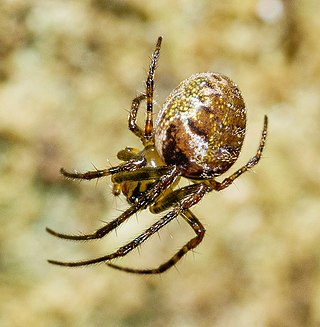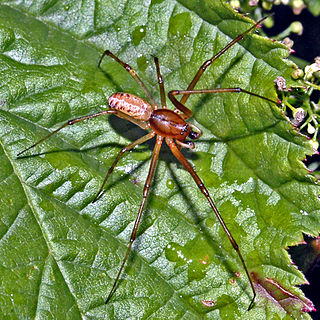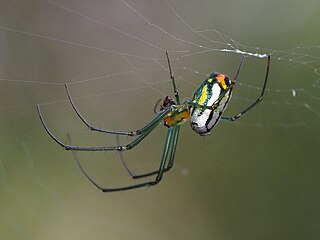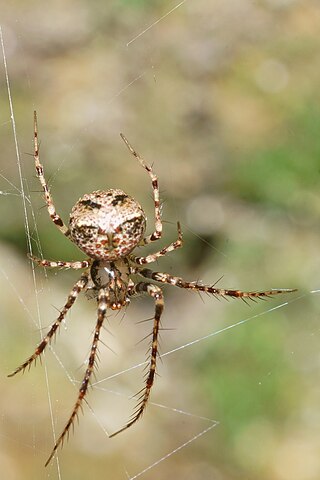
Huntsman spiders, members of the family Sparassidae, catch their prey by hunting rather than in webs. They are also called giant crab spiders because of their size and appearance. Larger species sometimes are referred to as wood spiders, because of their preference for woody places. In southern Africa the genus Palystes are known as rain spiders or lizard-eating spiders. Commonly, they are confused with baboon spiders from the Mygalomorphae infraorder, which are not closely related.

The bowl and doily spider is a species of sheet weaver found in North and Central America. It is a small spider, about 4 mm (0.16 in) long, that weaves a fairly complex and unique sheet web system consisting of an inverted dome shaped web, or "bowl," suspended above a horizontal sheet web, or "doily", hence its common name. The spider hangs from the underside of the "bowl", and bites through the web small flies, gnats and other small insects that fall down into the non-sticky webbing. The webs are commonly seen in weedy fields and in shrubs, and may often contain both a male and a female spider in late summer—like many linyphiids, Frontinella males and females may cohabitate for some time. Males exhibit competition for female mates both by fighting and sperm competition. Uniquely, these spiders exhibit behavioral thermoregulation and have lengthened circadian rhythms.

The Pholcidae are a family of araneomorph spiders. The family contains more than 1,800 individual species of pholcids, including those commonly known as cellar spider, daddy long-legs spider, carpenter spider, daddy long-legger, vibrating spider, gyrating spider, long daddy, skull spider, and angel spider. The family, first described by Carl Ludwig Koch in 1850, is divided into 94 genera.

Psechridae is a family of araneomorph spiders with about 70 species in two genera. These are among the biggest cribellate spiders with body lengths up to 2 centimetres (0.79 in) and funnel webs more than 1 metre in diameter.

Microlinyphia is a genus of dwarf spiders that was first described by U. Gerhardt in 1928.

Microlinyphia pusilla is a species of spider belonging to the family Linyphiidae. It has a Holarctic distribution.

Taraire is a small genus of Polynesian long-jawed orb-weavers. The genus was first described by A. Álvarez-Padilla, R. J. Kallal and Gustavo Hormiga in 2020, and it has only been found in New Zealand. They build vertical orb webs near forest floors, and can be found resting in the center. The genus name is a reference to Beilschmiedia tarairi, the native New Zealand tree that they are commonly found in.

Linyphia triangularis is a European species of spider in the family Linyphiidae first described by Carl Alexander Clerck in his 1758 Svenska Spindlar.

Neriene montana is a species of spider belonging to the family Linyphiidae. With a holarctic distribution, it is found throughout northern Europe.
Laetesia peramoena is a species of sheet weaver endemic to New Zealand.
Laetesia trispathulata is a species of sheet weaver spider found in New Zealand.
Laetesia aucklandensis is a species of sheet weaver found in the Auckland Islands.

Linyphia is a genus of dwarf spiders that was first described by Pierre André Latreille in 1804. The name is Greek, and means "thread-weaver" or "linen maker".

Nanometa purpurapunctata is a species of spider in the family Tetragnathidae. It is found in New Zealand.
Estrandia is a monotypic genus of dwarf spiders containing the single species, Estrandia grandaeva. It was first described by H. H. Blauvelt in 1936, and has only been found in China, Japan, and Russia.

Frontinellina is a genus of dwarf spiders that was first described by P. J. van Helsdingen in 1969. As of May 2019 it contains only three species, found in Kazakhstan, Portugal, Russia, South Africa, and Turkey: F. dearmata, F. frutetorum, and F. locketi.

Leucauge argyrobapta, or Mabel's orchard orb weaver, is a species of long-jawed orb weaver in the spider family Tetragnathidae. It is found in Southern part of the USA, Mexico and Brazil, further testing must be done to see if it is found in more of Central and South America.

Australomimetus sennio is a species of Mimetidae that is endemic to New Zealand.
Mangua forsteri is a species of Physoglenidae spider endemic to New Zealand.












